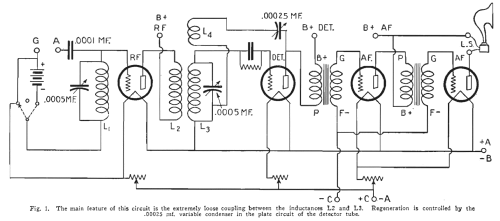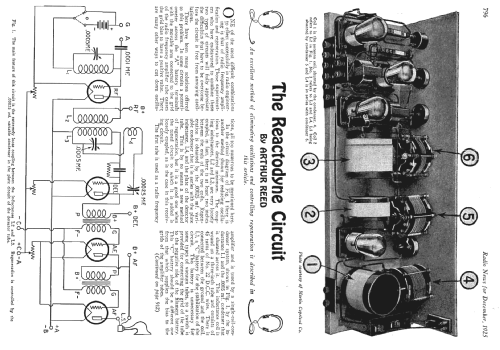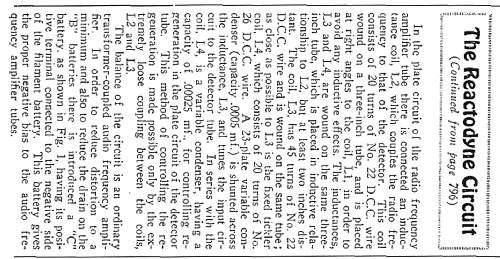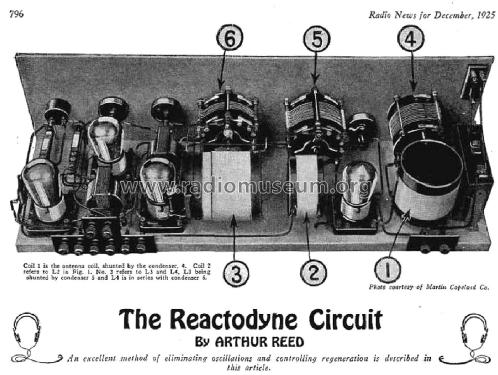Reactodyne Mar-Co
Martin Copeland Co. (MAR-CO); Providence, RI
- Country
- United States of America (USA)
- Manufacturer / Brand
- Martin Copeland Co. (MAR-CO); Providence, RI
- Year
- 1925
- Category
- Kit (Parts plus instruction) or building instructions only
- Radiomuseum.org ID
- 46833
Click on the schematic thumbnail to request the schematic as a free document.
- Number of Tubes
- 4
- Valves / Tubes
- Main principle
- TRF without regeneration
- Wave bands
- Broadcast only (MW).
- Power type and voltage
- Storage and/or dry batteries
- Loudspeaker
- - This model requires external speaker(s).
- Material
- Various materials
- from Radiomuseum.org
- Model: Reactodyne Mar-Co - Martin Copeland Co. MAR-CO;
- Notes
-
The Reactodyne Circuit
By Arthur Reed (with minor edits)One of the most difficult combinations to effect successfully in radio engineering is that of radio frequency amplification and regeneration. Those experimenters who have endeavored to combine these two types or circuits will fully appreciate the difficulties that have to be overcome before the circuit is free from annoying oscillations.
There have been many solutions offered to this problem. In some circuits a potentiometer across the "A" battery terminals with the movable arm connected to the grid of the radio frequency amplifier tube causes the grid bias to have a positive value.
There are many other ways to cut down oscillations, all too numerous to be mentioned here. In the circuit diagram of Fig. 1 there is another method shown for reducing oscillations to the desired minimum. The coupling inductances, L2 and L3, are very loosely coupled. There is at least two inches between the ends of the two coils. Regeneration is obtained by the 0.00025 mfd variable condenser that is in series with the plate inductance, L4, and the plate of the detector lube. This is by no means a new method of regeneration, but it is a good one when the tuned circuit to which it is added is loosely coupled, as is the case in this receiving circuit.
The first tube is used as a radio frequency amplifier and is tuned by a single coil condenser system, shown in Fig. 1, by the inductance L1 and the 0.0005 mfd condenser that is shunted across it. This inductance coil is wound on a three-inch tube and consists of 45 turns of No. 22 D.C.C. wire. Connected between the ground and coil L1 is a "C" battery for the stabilization of the circuit. This battery is unnecessary for some types of vacuum tubes, so a switch is provided for connecting the tube grid to the negative side of the filament battery. This "C” battery should be different than the grid battery for the amplifier tubes.
In the plate circuit the radio frequency amplifier tube is connected to inductance coil L2, which couples the radio frequency to that of the detector. This coil consists of 20 turns of No. 22 D.C.C. wire wound on a three-inch tube, and is placed at right angles to coil L1 in order to avoid any inductive effects. The inductances, L3 and L4, are wound on the same three-inch tube, which is placed in inductive relationship to L2, but at least two inches distant.
Coil L3 has 45 turns of No. 22 D.C.C. wire and is wound on the same tube and as close as possible to L3 and the fixed tickler coil, L4, which consists of 20 turns of No. 26 D.C.C. wire. A 23-plate variable condenser (capacity 0.0005 mfd) is shunted across the inductance, L1, and tunes the input circuit to the detector tube. In series with coil L4 is a variable condenser having a capacity of 0.00025 mfd, for controlling regeneration in the plate circuit of the detector tube. This method of controlling regeneration is made possible only by the extremely loose coupling between the coils, L2 and L3.
The balance of the circuit is an ordinary transformer coupled audio frequency amplifier. In order to reduce distortion to a minimum and also to reduce the drain on the "B" batteries there is a "C" battery as shown in Fig. 1, having its positive terminal connected to the negative side of the filament. This battery gives the proper negative bias to the audio frequency amplifier tubes.
By Arthur Reed in Radio News, December 1925, Pages 796 & 912.
- Price in first year of sale
- 25.00 $
- External source of data
- Ernst Erb
- Source of data
- Radio Collector`s Guide 1921-1932
- Mentioned in
- -- Original prospect or advert (Radio News, December 1925, Page 796)
- Other Models
-
Here you find 5 models, 4 with images and 2 with schematics for wireless sets etc. In French: TSF for Télégraphie sans fil.
All listed radios etc. from Martin Copeland Co. (MAR-CO); Providence, RI



